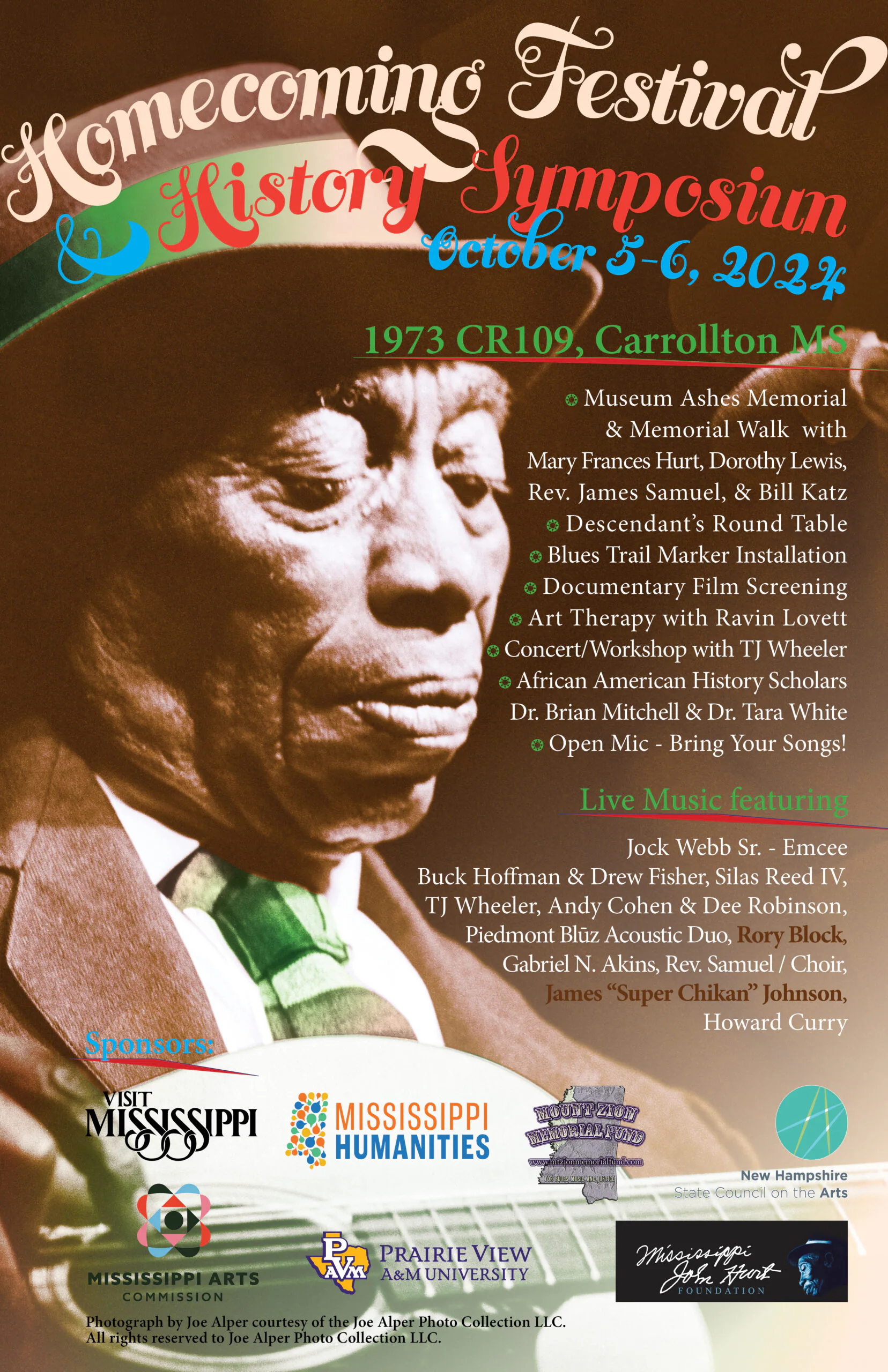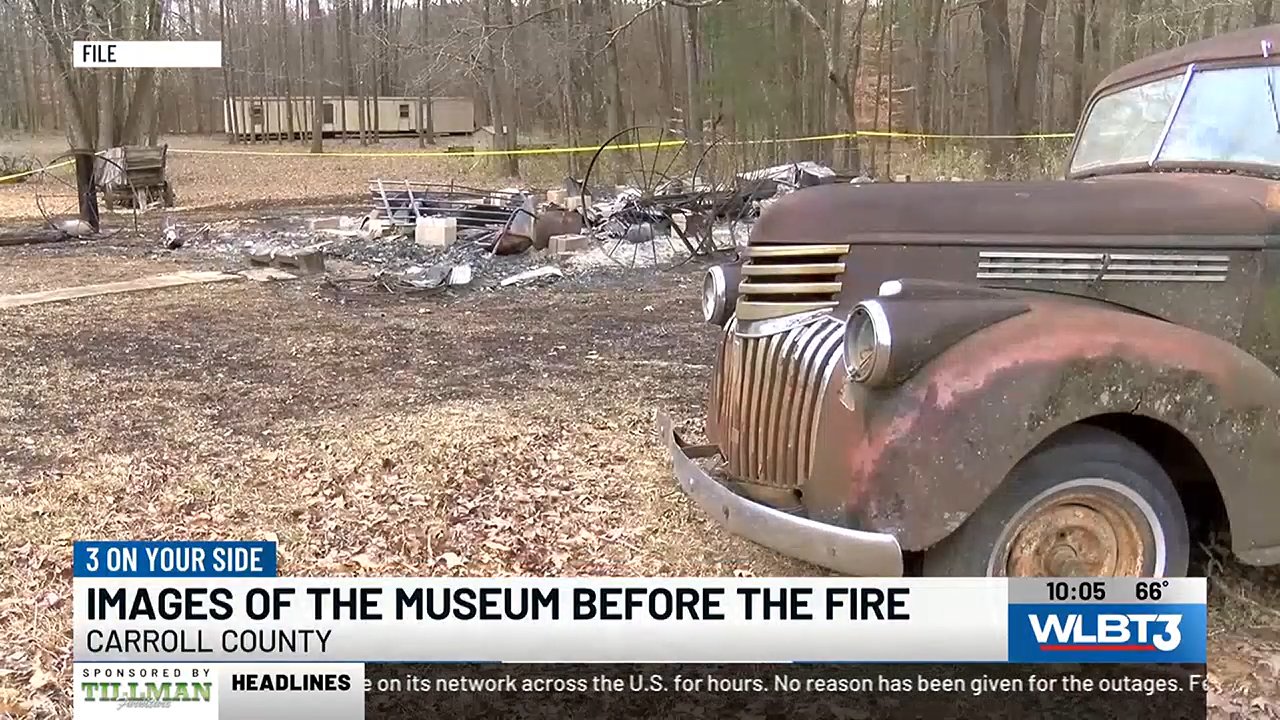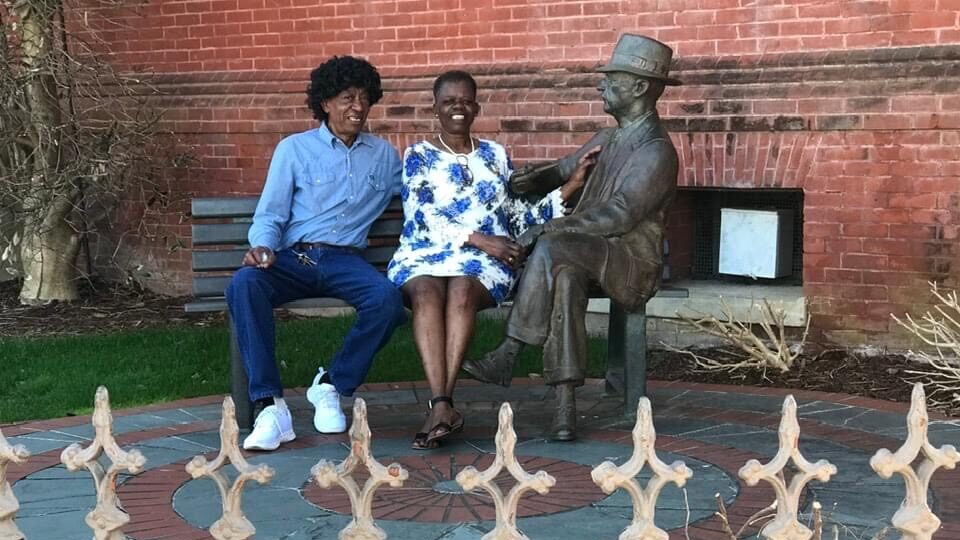Saga Unfolds in
Hurt Museum Fire
& “Missing”
Historical Marker

This article was originally published in the Jackson (MS) Clarion Ledger on April 1, 2024.
AVALON, Miss. — The mystery surrounding the missing blues trail marker honoring legendary bluesman Mississippi John Hurt and the cause of the Mississippi John Hurt Museum fire is as winding as the maze of narrow roads that crisscross the Eastern edge of the Delta.
Unraveling the winding mysteries is a complicated task.
The two incidents occurred just over a week apart from one another, forming a plausible thought that the alleged stolen marker and the destroyed museum were connected.
As authorities continued their investigation, police statements issued via press release conflicted with the accounts and claims made by one of John Hurt’s family members.
Questions arose.
Where is the marker? Was it ever stolen? What was the cause of the fire that destroyed a building with such cultural and historical value?
Initial reports from the Carroll County Sheriff’s Office stated the marker was “stolen” during a March 4 break-in at the Valley Store in Carroll County. The break-in happened over a week after the Mississippi John Hurt Museum was destroyed by a fire. The day after the marker was allegedly stolen, the sheriff’s office released another statement notifying the public that the iconic blues musician’s historical marker was “confirmed to be in the possession” of the Hurt family.
But a family member who talked to the Clarion Ledger stated otherwise.
Mary Hurt, granddaughter of John Hurt and the founder of Mississippi John Hurt Museum, told the Clarion Ledger on March 7 that no one in her family had possession of the marker. Mary also leads the charitable foundation that supports the museum.
“[Carroll County Sheriff Clint Walker] did not call me about the marker. He talked to someone to find out where it was, but we do not have that marker,” Hurt told the Clarion Ledger.
Here’s what we know about the travel of the marker:
- Sheriff Walker confirmed to the Clarion Ledger that the marker was never stolen.
- Mary Hurt confirmed to the Clarion Ledger that members of the foundation are the ones who moved the marker from the Valley Store. There are only six members of the foundation listed on the most recent federal 990 form available to the public. Mary Hurt is one of those six. The foundation’s website lists five members. She did not specify which foundation member took the marker.
- Allan Hammons of Hammons and Associates of Greenwood, the company that oversees the design and placement the markers at a site, confirmed to the Clarion Ledger on March 14 that the company received possession of the marker the evening of March 7. While at the company, it will undergo routine cleaning and maintenance.
- Afterward, it will be placed at a new site per the direction of Visit Mississippi, a division of the Mississippi Development Authority, director Rochelle Hicks said. Hicks told the Clarion Ledger on March 21 a new site has yet to be determined since the John Hurt Museum, which was burned down, was slated to be the new site for the marker. Hicks said Visit Mississippi and the Mississippi Blues Commission are in discussion about other potential sites for the marker.
Sheriff Walker told the Clarion Ledger the report of the “stolen” marker came about because no one, to his knowledge, notified the Valley Store landowners that the marker would be moved.
“The lack of communication between those two parties — Mary Hurt and the landowners — that the marker would be moved led to a report being filed as it being stolen,” Walker said. “The owners of the Valley Store reported the crime, and we reported it to the public.”
But why was the marker removed in the first place?
Racial Segregation
In an interview with Mary Hurt, she told the Clarion Ledger she fought “for years” to relocate the marker from the Valley Store, which was erected by the Mississippi Blues Commission on Feb. 25, 2008.
Hurt said she wanted the marker moved because it should be placed where John Hurt had “deeper connections.” Not at a location, where Hurt said, it would have been “impossible for him to play at because of the Jim Crow Era.”
Conflicting Accounts
The Clarion Ledger reached out to the Mississippi Blues Commission researchers to clarify John Hurt’s connection to the Valley Store, considering the department’s records say John Hurt used to play his guitar while sitting on the steps of the Valley Store.
“The decision was made to put it at the Valley Store because it seemed to be a good location in between the gravesite and spot where his house had been moved. It was already a known location for die-hard blues fans around the world,” Wanda Clark, creative director under the Mississippi Blues Trail, told the Clarion Ledger via email.
Clark provided the Clarion Ledger links to pages from a book detailing John Hurt’s connection to the Valley Store. The book titled Mississippi John Hurt: His Life, His Times, His Blues was written by Philip Ratcliffe and published in 2011 by the University Press of Mississippi.
Clark said the book appeared to have been “well researched and documented with footnotes.” Mary Hurt wrote the foreword — a piece of writing that normally endorses or adds credibility to the author and their work.
One excerpt on page 17 reads, “… [John] would sit and play his guitar outside the Valley Store and listen to the local gossip.”
“… John spent much of his early teens hanging out with these white children around the Valley area, apparently with little racial complication,” another excerpt on page 32 states.
And on page 39, the book states John had a “close relationship” with the succession of owners of the Valley Store. There was also a picture of John Hurt centered at the top of page 133 “with friends on the front porch of the Valley Store” dated March 1963, around three years before Hurt passed away.
Part of Mary Hurt’s foreword reads:
“I am so grateful to Phil for all the hard work, travel, resources, and in-depth research, that have been applied in order to write this wonderful biography of Daddy John’s life. It will be a prized resource for my family generations to come.”
Museum curator Floyd Bailey concurred with the book, and said that Mississippi John Hurt performed at the Valley Store on Saturday nights.
Even though conflicting narratives exist regarding the marker’s placement at the Valley Store, one thing is certain: Mary Hurt was approved to relocate the marker. This approval by the blues commission was granted almost a year ago.
“It was June 2023, when I petitioned to the blues commission for the marker to be relocated to my grandfather’s house or the community church. The blues trail marker sitting in front of the store, which has been abandoned for many decades, had no connection to my grandfather’s life at all,” Hurt said. “I presented my case to the Mississippi blues commission, and they agreed the marker should be relocated.”
After authorization was given to Hurt, Hurt said she went to the Carroll County Board of Supervisors in October 2023 and December 2023, but no progress in moving the marker was ever made.
Hurt provided the Clarion Ledger with the letter of confirmation she received from the blues commission on or around June 15, 2023. The letter states the site change was voted on and approved by the Mississippi Blues Commission.
Hicks confirmed to the Clarion Ledger this information was true by providing the Clarion Ledger a copy of the letter as well.
Hurt told the Clarion Ledger she sees the store break-in as a way to “cover up of the real tragedy” that occurred on Feb. 21: the fire at the Mississippi John Hurt Museum.
It was reported in the afternoon of Feb. 21 by the Carroll County Sheriff’s Department that a Delta Electric service technician was dispatched to the museum’s location. Upon arrival, the technician found the museum “fully engulfed in flames.”
Walker stated the cause stemmed from an electrical fire with no foul play suspected at this time.
Hurt claimed arson.
“Sheriff Walker is talking about a marker that is still here. And if someone does destroy that marker, it could be made again,” Mary said. “But this 200 year-old house, that was burned down for racial reasons, cannot.”
Hurt said the day before the fire, the museum received recognition on the National Register of Historic Places. And hours later, the building went up in flames and down in ashes.
“My grandfather and his mother owned that house since 1837. That house was all of my relatives, all of them. It’s like I’m burying generations of my family all over again. Seeing that place — that empty field — where the house sat for so many years is now nothing but cinders,” Hurt said.
Hurt told the Clarion Ledger on March 28 the Mississippi State Fire Marshal chief confirmed to her that the cause of fire was not an electrical one, as indicated in February reports by Carroll County police. Hurt did add that no official report has been released.
State Fire Marshal officials also confirmed to the Clarion Ledger on March 28 that no official report has been issued.
“We have not released a cause of the fire because we are still waiting on official test results, and we will not rule out anything until the official test results are in,” officials with the state office told the Clarion Ledger.
The Fire Marshal’s Office responded to the Feb. 21 scene with other departments such as the Bureau of Alcohol Tobacco and Firearms, the Federal Bureau of Investigation and the Mississippi Bureau of Investigation.
The office said it is unknown at this time when those findings will be solidified.
According to Hurt, racial factors are the underlying cause behind the burning of the museum. Hurt accused the Carroll County police department of “race baiting” — using statements about race to often intentionally influence racism or anger toward a specific group of people.
In response to Hurt’s claims, Walker told the Clarion Ledger he found Mary statements to be “totally false.” Walker said the department has never been accused of “race baiting” to his knowledge.
“Like I stated before, if she would have notified the owners of the property that she removed the marker. We wouldn’t even have had a phone call out there for an investigation. But due to her lack of inability to relay information to the owners about the marker, it led to a lot of man hours and investigation hours that could have been used somewhere else,” Walker stated via phone call.
To Mary, the investigation hours should have been placed “somewhere else” — the fire at the museum.
“The fire was 100 percent investigated by every federal, state and local agency. So, every effort exhausted was exhausted to investigate it. And like I’ll say again, if she wouldn’t have gone and removed the marker, I wouldn’t have had to waste time and county taxpayer money to investigate a crime that didn’t even happen,” Walker told the Clarion Ledger.
“So, as you can probably tell in my voice, I do not appreciate Ms. Hurt making accusations against the Sheriff’s Department of racially motivating the investigation. There’s no evidence of a crime. From the federal level to the state level to the local level, it appears at this time it was an electrical fire,” Walker stated. “No evidence supports any criminal act.”
Walker told the Clarion Ledger he did not want to answer any more questions regarding any comments or accusations made by Hurt.
“I really appreciate the help from all the state and federal agencies quick response into investigating this historic landmark in our county,” Walker said. “And again, I do not appreciate Ms. Hurt making accusations that something we’ve done was racially motivated. There’s no evidence to support that or substantiate it, and I strongly object to any comments she makes about that toward this department.”
With the loss of the museum, Hurt said an old church in Avalon is the only material remnant of John’s history. Avalon is an all-Black town in the eastern Mississippi Delta. All she has now are memories. Hurt was 9 years old when her grandfather died in 1966.
“My grandfather was the kindest, gentlest and most humane human being that I have ever met in my life. He would smile and reach out to people and try to help anybody regardless of race. Yes, he was a musician. Yes, he was a self-taught musician. But for me, he was the motivator behind me as a human being,” Mary stated.










